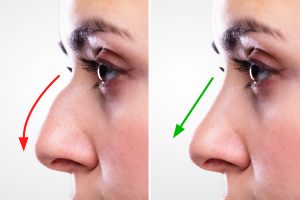 People decide to get cosmetic or functional nose reshaping surgery – medically known as rhinoplasty – for various reasons, ranging from straightening a broken nose to fixing a breathing issue.
People decide to get cosmetic or functional nose reshaping surgery – medically known as rhinoplasty – for various reasons, ranging from straightening a broken nose to fixing a breathing issue.
According to the American Society of Plastic Surgeons, nose jobs are one of the most-popular plastic surgeries. In 2019, more than 207,000 procedures were performed.
Patients pursuing cosmetic rhinoplasty often say that asymmetry is something they want to fix. For instance, a nose that leans too far to the left or right can draw unwanted attention from the rest of the face.
There are various ways that a board-certified plastic surgeon can alter a profile through nose surgery. These include: Changing nose size in relation to facial balance; changing nose width at the bridge; removing visible humps or bridge depressions; reworking the nasal tip; or changing the size and position of the nostrils.
The goal is altering the shape and proportion of the nose to harmonize with the entire face.
A second reason for rhinoplasty is to correct breathing issues. One of the most common causes of breathing impairment is a narrowing of nasal passages and crooked – or deviated – cartilage known as the septum. Straightening the septum, a procedure known as a septoplasty, positions the cartilage so that it sits properly vertical and allows air to move more easily through each nostril.
Another common breathing issue is a result of allergies or sinus infections which can cause some small structures inside the nose, called turbinates, to enlarge and inhibit airflow on both sides of the nose. Turbinate reduction can provide more open space for airflow.
While nose surgeries that adjust the nasal structure can improve breathing, in many cases, correcting obstructed airflow also can create an aesthetically pleasing external shift.
Rhinoplasty is an outpatient procedure that takes approximately one to two hours to perform. To minimize scarring, incisions are placed inside the nose or in the line where the nose meets the cheek. During the procedure, the surgeon manipulates the bone and cartilage of the nose to form the desired shape. Regardless of the type of nasal surgery, patients should expect to wear a splint for about a week afterward to hold the tissues in place and ensure they heal properly. Bruising and swelling may last for about two weeks. The nose heals slowly and can take up to a year to be fully healed after surgery. Talking about the healing process with your board-certified surgeon will assure your recovery is handled correctly.
All plastic surgeons have individualized rhinoplasty approaches and no two will perform the surgery the same way. Therefore, who you choose will greatly determine your results. It’s important to meet with a board-certified plastic surgeon to determine if rhinoplasty is right for you. To find a highly qualified plastic surgeon, utilize our Dallas Society of Plastic Surgeons member directory.
